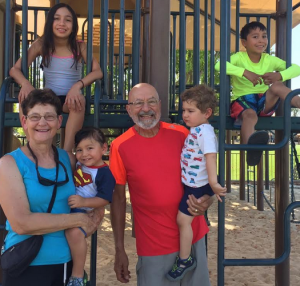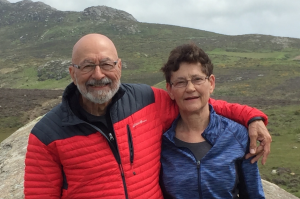
Dr. Carol LaHurd and Dr. Ryan LaHurd—a couple whom many Auggies will remember with gratitude and respect

—have recently made an endowed gift to Augsburg through a bequest for the MAL (Master of Arts in Leadership) program. Both LaHurds have spent most of their lives in higher education, and Ryan LaHurd served as Augsburg’s Vice President for Academic Affairs and Dean of the College from 1985 to 1994. He was, in fact, instrumental in creating the MAL program.
Having served in various higher education settings throughout their professional lives, the LaHurds made this commitment because they feel that Augsburg University “stands out as an institution that truly lives out its mission”…preparing future leaders who are committed to the good of all people, dealing with the challenges (and benefits) of the urban environment, and making higher education truly accessible to people of many different backgrounds and abilities.
These are values by which the LaHurds have been guided as well, and therefore readily embrace. In their view, many institutions have stated a goal of a diverse student body, but Augsburg has actually built and nurtured a system of support to make success possible for students—a long-term effort that was expensive in energy and money, and one that remains a strong and impressive commitment.
Ryan LaHurd—whose professional life in higher education has also included positions at Allentown College, Thiel College, and Lenoir-Rhyne University (where he served as president)—later served as executive director of the Near East Foundation, a private, nonprofit development agency in New York. Between 1981 and 1993, he was afforded rich international experiences through three Fulbright Senior Fellowships—teaching American literature and culture at the University of Damascus, Syria; studying higher education in the Federal Republic of Germany; and teaching American literature and conducting research at the University of Sana’a, Yemen.
Most recently, at the James S. Kemper Foundation, Ryan LaHurd oversaw a comprehensive talent identification and leadership development program (which included scholarships, coaching, internships, and mentoring), designed to shape well-rounded future business leaders, particularly for the insurance industry. This work represented a bit of a shift in his career, and since retiring as the Foundation’s president in May 2016, he has been considering the idea of writing a book or article to help college students bridge their education to the world of work, drawing parallels with his own learnings and experiences in building a bridge from his years in academia to his work at the Kemper Foundation.
A conversation with Ryan LaHurd will likely lead at some point to his two professional passions—church-related higher education, and involvement with international issues, especially the Middle East. One particularly gratifying experience stands out in his memory, when the two intersected. During his time at Augsburg, he was invited to do an interview on the local public radio station, and explain the history of conflict in the Middle East stemming from World War I. The interview led to numerous educational presentations, including a large anti-war rally on the University of Minnesota campus. As an Arab American, Ryan found the ensuing conversations very meaningful, not only in terms of melding his career as a teacher with his experience in and study of the Middle East, but also of helping others gain a greater understanding of the role Great Britain and France played in laying foundations for the ongoing conflict in the Middle East, and moving beyond the perception that the problems stem from Arabs’ being a conflict-prone people.
Though the LaHurds have found a slightly different pace in retirement, their days are full, especially as they provide care two days a week for their almost-three-year-old grandson (and soon, also, his new baby sister). Ryan says he finds great joy, excitement, and personal growth in being able to experience his grandson’s view of things—and this has helped him understand why Jesus said we need to become like little children. Recently, he completed an article called “The Spirituality of Grandparenting,” which he hopes to have published.
Since the LaHurds moved to Chicago in 2006, Carol LaHurd taught religion at the Lutheran School of Theology at Chicago (LSTC) for ten years. Since then, she has adjusted her commitments to align with the demands of doing half-time child care. She continues to be a volunteer educational outreach consultant for LSTC’s Center of Christian-Muslim Relations for Peace and Justice. Between 2006 and 2011, she coordinated efforts by staff in various ELCA units to achieve the three main goals of the Middle East peace strategy adopted by the ELCA Churchwide Assembly in 2005—accompaniment, awareness, and advocacy.
These days, she is mainly writing and speaking about how we Americans can better understand Islam and Muslims, and more positively engage religious others. She has written a year-long Bible study for ELCA’s Gather magazine, and serves as a member of ELCA’s Consultative Panel on Lutheran-Muslim Relations and the Inter-Religious Task Force to draft “A Declaration of Our Inter-Religious Commitment: A Policy Statement of the Evangelical Lutheran Church in America.” She also served as lead editor and one of the authors for the 2016 book, Engaging Others, Knowing Ourselves: A Lutheran Calling in a Multi-Religious World.
As she reflects on changing and evolving attitudes among students at LSTC, as well as in her earlier teaching experiences at Fordham University, Wake Forest University, and the University of St. Thomas, she says she sees hopeful signs in the increasing student interest in, and passion for, relating Christian theology and ethics to social justice issues—as well as for engaging people of other religious traditions, first as students and then as church leaders. She takes heart that people of faith are “speaking out and taking joint action on social justice issues that connect directly to shared religious commitments, such as welcoming the stranger, caring for the earth, and seeking constructive relationships among those of diverse backgrounds and ethnicities.”
Though we live in rather pessimistic times, the LaHurds say they see the most hopeful signs on a smaller scale, notably in the work of nongovernmental groups and religious organizations, and in their commitment to bring people together across religious and ethnic lines, helping them to build solid economies and peaceful communities.
–by Cheryl Crockett ‘89
